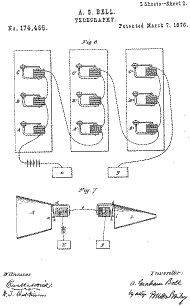 | ||||||||||||||
|
Contents
| ||||||||||||||
| ||||||||||||||
|
| |||
The Dawn of a New Era
Alexander Graham Bell was actually trying to improve the telegraph when he realized that somebody's voice could be reproduced in another location by hooking up a microphone in one place to a speaker in different place through a pair of wires. This simple yet profound idea almost instantly changed the way people and organizations communicate and started a whole new industry. The first telephone did not have a dial, let alone a key pay. There was only one other phone in the world to call - the one next door.
Point To PointThe first telephone lines were set up to connect individual pairs of telephones. There were still no numbers to call. You simple picked up the receiver and cranked a handle on a little generator that would generate enough electricity to ring a bell at the other end. Then, hopefully, somebody there would know to pick up the receiver. Parts of the world were already strung with wires for telegraph service, so adding a few more wires or repurposing existing ones was relatively straight forward. Point to point connections, also known as dedicated lines, sprung up in several places. If you wanted to be able to talk to people in different locations, you would need a line connecting your office to each destination, and one at each end of every line. There are several problems with this, some more obvious than others. First, you can only call one place. Second, stringing lines over long distances is horrendously expensive and only insanely rich individuals or big organizations could afford it. Sharing LinesEntrepreneurs quickly realized that they can invest some money into stringing cable around the countryside and then let others use those lines, for a fee, until the end of time. More importantly, they could use the same lines for many customers by connecting customer phones to shared lines only on demand. Faster than you could say "cell tower", telephone cables were strung throughout cities world wide to provide telephone service to larger and larger numbers of customers. Ladies donning bolbous beaufonts (aka Bee Hive hairdoos) were hired to sit in offices relatively close to the customers (local exchanges). From there, dedicated (local) lines ran to individual customers. The exchanges were connected to other exchanges including exchanges in other cities. Customers were assigned numbers, eliminating the need for those ladies to remember which customer was connected to what local line. It was a time of furious capital investment and technological innovation. Then, for for the next 3/4 century, telephone services got a little cheaper, more reliable, and easier to use, but precious little changed until the introduction of the cell phone and the internet based telephony. | |||
